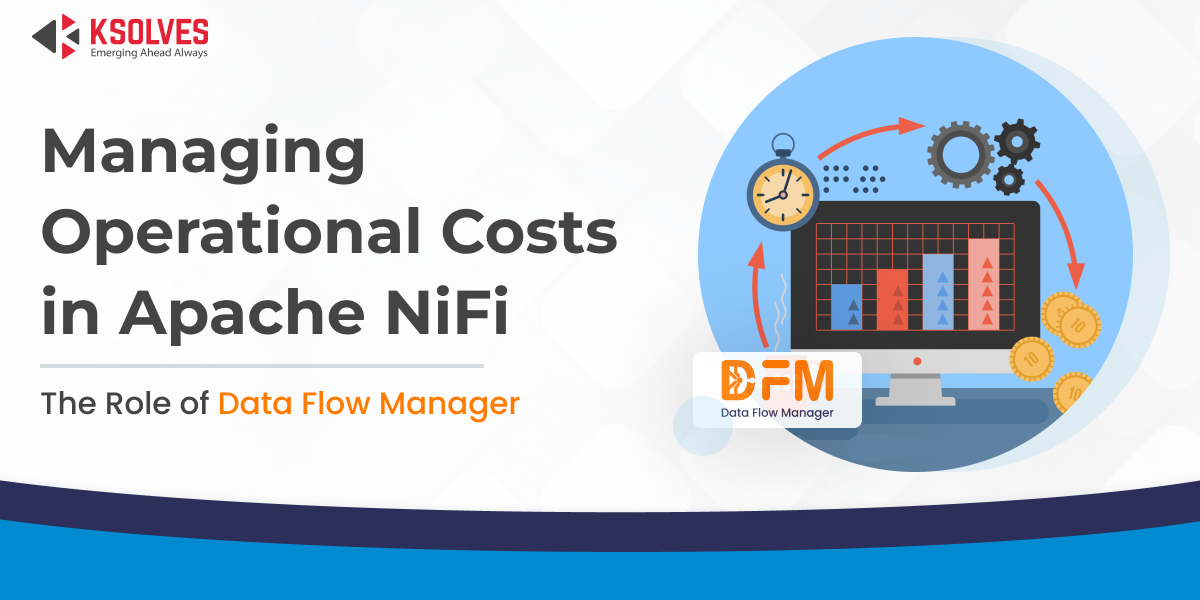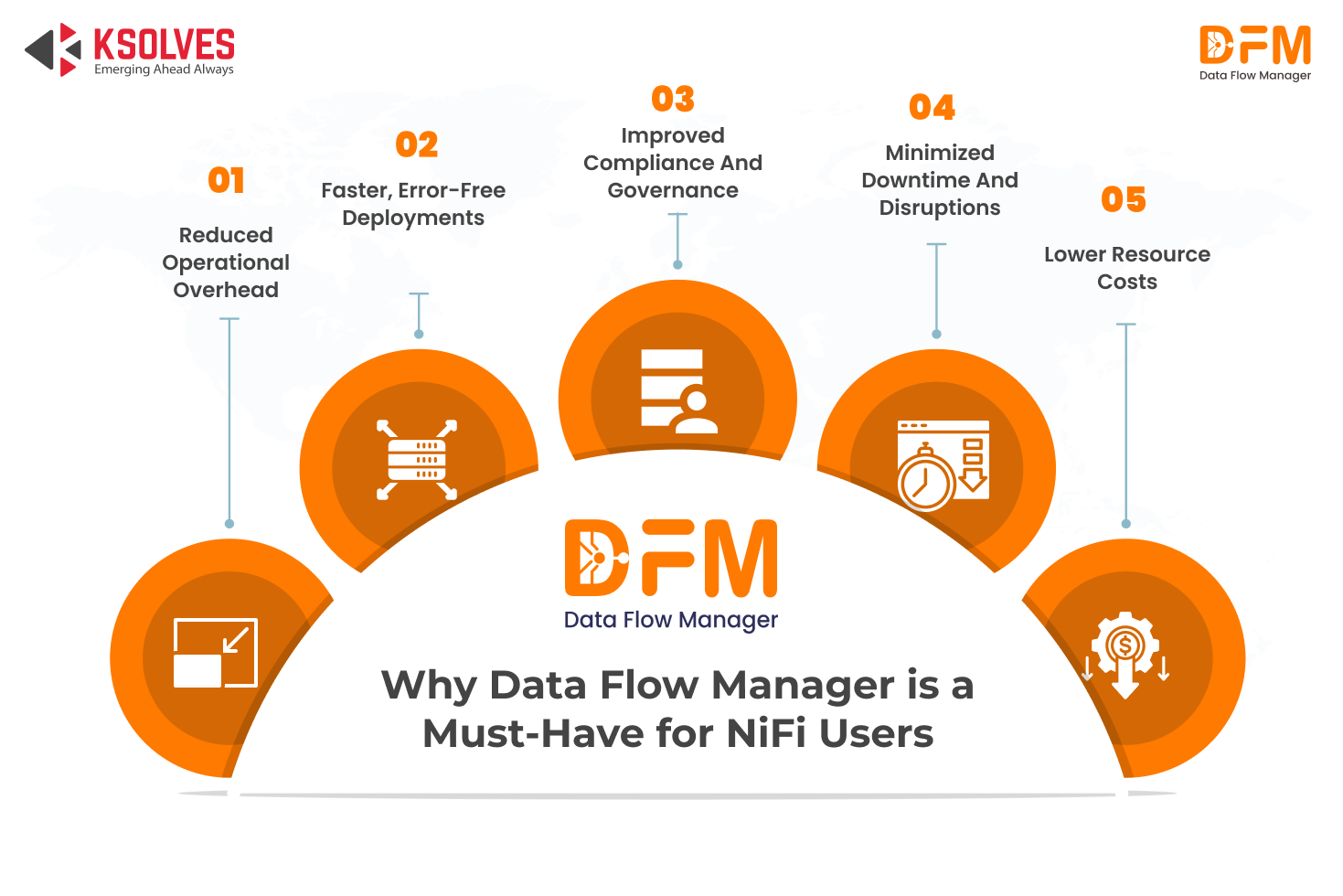How Does Data Flow Manager Reduce Operational Costs in Apache NiFi?
![]()

Apache NiFi, being open-source, has become a go-to platform for many organizations to automate the flow of information between disparate systems. What makes it stand out is its web-based graphical user interface that lets you create and manage data flows effortlessly. You simply need to drag and drop the components to data flows. As a result, it is widely known as a flow-based data processing engine.
Though Apache NiFi simplifies data operations with its GUI and flow-based approach, it poses significant challenges in managing and deploying data flows.
One of the most common challenges is high operational costs. Deploying and managing NiFi flows across clusters requires significant manual effort, which is time-consuming, error-prone, and resource-intensive. This, in turn, incurs operational costs, reduces efficiency, and impacts business agility.
This is where Data Flow Manager steps in. It is a robust data flow automation solution, developed by Ksolves India Limited, to streamline NiFi flow deployment and management.
Let us explore how Data Flow Manager helps reduce operational costs for businesses utilizing Apache NiFi.
The Hidden Costsff Managing NiFi Data Flows
While NiFi provides exceptional capabilities for data processing, managing data flows typically introduces cost-intensive challenges. As many organizations overlook these challenges, they end up spending hefty amounts. Not only do these challenges strain organizations financially, but they also in terms of overall performance and efficiency.
1. Manual Data Flow Deployment
Typically, when NiFi developers want to move their data flows from one cluster to another, they follow a tedious process.
- Export a specific data flow as a template from NiFi’s UI.
- Save it as a local file on the system (if NiFi registry is not used).
- Log in to the target cluster.
- Import the locally saved flow file to the target cluster.
- Tune the flow configurations, such as parameter contexts, variables, and controller services.
- Test the flow and run it in the production environment if it functions as expected.
This entire process is time-consuming, slowing down the deployment cycle and delaying data operations.
2. High Risk of Errors
NiFi data flows are a collection of interconnected processors, connections, FlowFiles, and other components. In addition, each NiFi cluster has its own configurations. As a result, when you move a data flow from one cluster to another, it is necessary to take care of the cluster-specific configurations.
When you deploy a data flow to the target cluster, you must update flow parameters, variables, and controller services. Doing this manually increases the risk of human errors, leading to misconfigurations. In case of any errors, debugging and rectifying them require additional effort.
Manual data flow deployment demands the need for technical personnel, ample time, and the cost of rework in the event of errors. Consequently, it increases operational costs and delays critical business processes.
3. Dependency on Skilled Developers
NiFi data flow management requires technical expertise to avoid any kind of misconfiguration and inaccuracy in outcomes. As a result, organizations need dedicated personnel to handle such repetitive tasks precisely, which significantly increases labor costs.
In the case of limited human resources, this dependency can create bottlenecks, delaying deployments and reducing organizational agility.
4. Lack of Centralized Flow Management
In an organization, multiple teams work on NiFi. As a result, managing data flows across teams becomes complex. Without a centralized system, it becomes challenging to keep track of changes to every data flow.
Many times, teams can create duplicate data flows, leading to inefficiencies, version mismatches, and wasted development time. This results in higher costs due to rework and misaligned configurations.
5. Downtime and Performance Issues
A data flow with misconfigurations (which can occur due to human errors) can lead to unexpected failures, which can cause disruptions to the entire data pipeline. When data flows are not configured properly, they consume excessive resources leading to performance bottlenecks and even outages. This significantly affects business operations.
6. Slow Debugging and Troubleshooting Errors in Data Flows
In case of any issues in data flows, identifying and resolving them on time is critical to keep business operations running smoothly. Without proper version control, monitoring, and alerts, it is challenging for you to detect and troubleshoot errors in data flows timely.
If it takes longer to resolve issues, the cost considerably increases in terms of productivity and delayed processes.

How Data Flow Manager Reduces NiFi Operational Costs
Data Flow Manager is primarily designed to improve operational efficiency, reduce manual errors, and save operational costs by automating repetitive tasks. Here’s how it addresses the above challenges that incur operational costs:
1. Automated Data Flow Deployments
Data Flow Manager has a point-and-click interface that automates NiFi flow deployments across clusters. It eliminates the tedious, error-prone process of manual data flow deployments, cutting labor costs and minimizing human errors. As a result, you can save your team’s valuable time and invest it in driving innovation and business growth.
2. Consistent Flow Configurations across Clusters
With automated data flow deployments, Data Flow Manager ensures that flow configurations are consistent across clusters, without requiring you to manually fine-tune them. In addition, it provides the flexibility to edit parameter contexts and variables of your data flows and configure and add an existing or new controller service.
Consistent flow configurations improve data quality and ensure the accuracy of outcomes. With no misconfigurations, you can save a lot on rework.
3. Reduces the Dependency on Technical Personnel
With the point-and-click interface, Data Flow Manager streamlines everything you need to do to manage your data flows. This significantly reduces the reliance on technical personnel, saving labor costs and freeing them to take on strategic initiatives.
4. Centralized Flow Management
Data Flow Manager provides a single dashboard to manage, monitor, and control all NiFi flows. This eliminates silos, reduces redundancy, and ensures better coordination among teams, leading to improved resource utilization and reduced operational overhead.
With role-based access control, you can also enforce governance policies. This helps them ensure that only authorized personnel can modify critical data flows, thereby improving security and compliance.
5. Monitoring and Alerts
Data Flow Manager provides real-time monitoring of NiFi data flows, automatically detecting anomalies such as flow failures, high CPU/memory usage, etc. With alerts, teams can proactively address issues before they escalate into costly incidents.
By reducing response time and minimizing downtime, you can avoid lost revenue and maintain continuous data processing.
6. Version Control and Rollback
Data Flow Manager introduces automated versioning, allowing teams to maintain a history of flow modifications, compare different versions, and instantly roll back to a stable version in case of failure.
This eliminates the need for manual rework, reduces debugging time, and prevents costly disruptions caused by configuration errors.
Conclusion
By addressing inefficiencies in deployment, configuration management, personnel dependency, monitoring, and troubleshooting, Data Flow Manager helps businesses cut down operational costs, enhance performance, and improve reliability. Its automation capabilities reduce manual workload, optimize resource utilization, and prevent costly failures, making it an essential tool for organizations leveraging Apache NiFi for large-scale data processing.
Want to reduce your organization’s operational costs? Book your free demo!
FAQs
- What are the benefits of version control and rollback in NiFi?
With automated version control, Data Flow Manager keeps track of changes made to NiFi flows, allowing users to compare versions and roll back to previous stable configurations if errors occur. This prevents time-consuming troubleshooting, reduces downtime, and ensures seamless data flow continuity, ultimately cutting operational costs.
- Is Data Flow Manager suitable for large-scale enterprise deployments?
Yes, it is designed to handle complex, high-volume data flows across multiple clusters. With its scalability, automation, and centralized control, enterprises can reduce operational overhead, ensure high availability, and optimize data processing costs efficiently.
- What industries can benefit from using Data Flow Manager for NiFi?
Industries that rely on real-time data processing and automation, such as finance, healthcare, retail, telecommunications, and logistics, can greatly benefit. By reducing manual intervention and improving operational efficiency, businesses can lower costs and enhance data-driven decision-making.
![]()